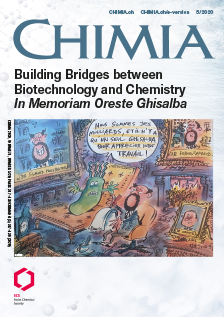Isolation and Identification of Actinomycetes Strains from Switzerland and their Biotechnological Potential
DOI:
https://doi.org/10.2533/chimia.2020.382PMID:
32482215Keywords:
Actinomycetes, Antibacterial compounds, Antismash, Cultivation, Drug discoveryAbstract
Actinomycetes strains isolated from different habitats in Switzerland were investigated for production of antibacterial and antitumoral compounds. Based on partial 16S rRNA gene sequences, the isolated strains were identified to genus level. Streptomyces as the largest genus of Actinobacteria was isolated the most frequently. A screening assay using the OmniLog instrument was established to facilitate the detection of active compounds from actinomycetes. Extracts prepared from the cultivated strains able to inhibit Staphylococcus aureus and Escherichia coli were further analysed by HPLC and MALDI-TOF MS to identify the produced antibiotics. In this study, the bioactive compound echinomycin was identified from two isolated Streptomyces strains. Natural compounds similar to TPU-0037-C, azalomycin F4a 2-ethylpentyl ester, a derivative of bafilomycin A1, milbemycin-α8 and dihydropicromycin were detected from different isolated Streptomyces strains. Milbemycin-α8 showed cytotoxic activity against HT-29 colon cancer cells. The rare actinomycete, Micromonospora sp. Stup16_C148 produced a compound that matches with the antibiotic bottromycin A2. The draft genome sequence from Actinokineospora strain B136.1 was determined using Illumina and nanopore-based technologies. The isolated strain was not able to produce antibacterial compounds under standard cultivation conditions. The antiSMASH bioinformatics analyses of the genome from strain B136.1 identified biosynthetic gene clusters with identity values between 4% to 90% to known gene clusters encoding antibiotics. The combinations of cultivation conditions, screening assays, analytical methods and genome mining are important tools to characterize strains of actinomycetes for the identification of their potential to produce natural compounds with antimicrobial activity.
Downloads
Published
Issue
Section
License
Copyright (c) 2020 Fabienne Arn, David Frasson, Ivana Kroslakova, Fabio Rezzonico, Joël F. Pothier, Rainer Riedl, Martin Sievers

This work is licensed under a Creative Commons Attribution-NonCommercial 4.0 International License.







